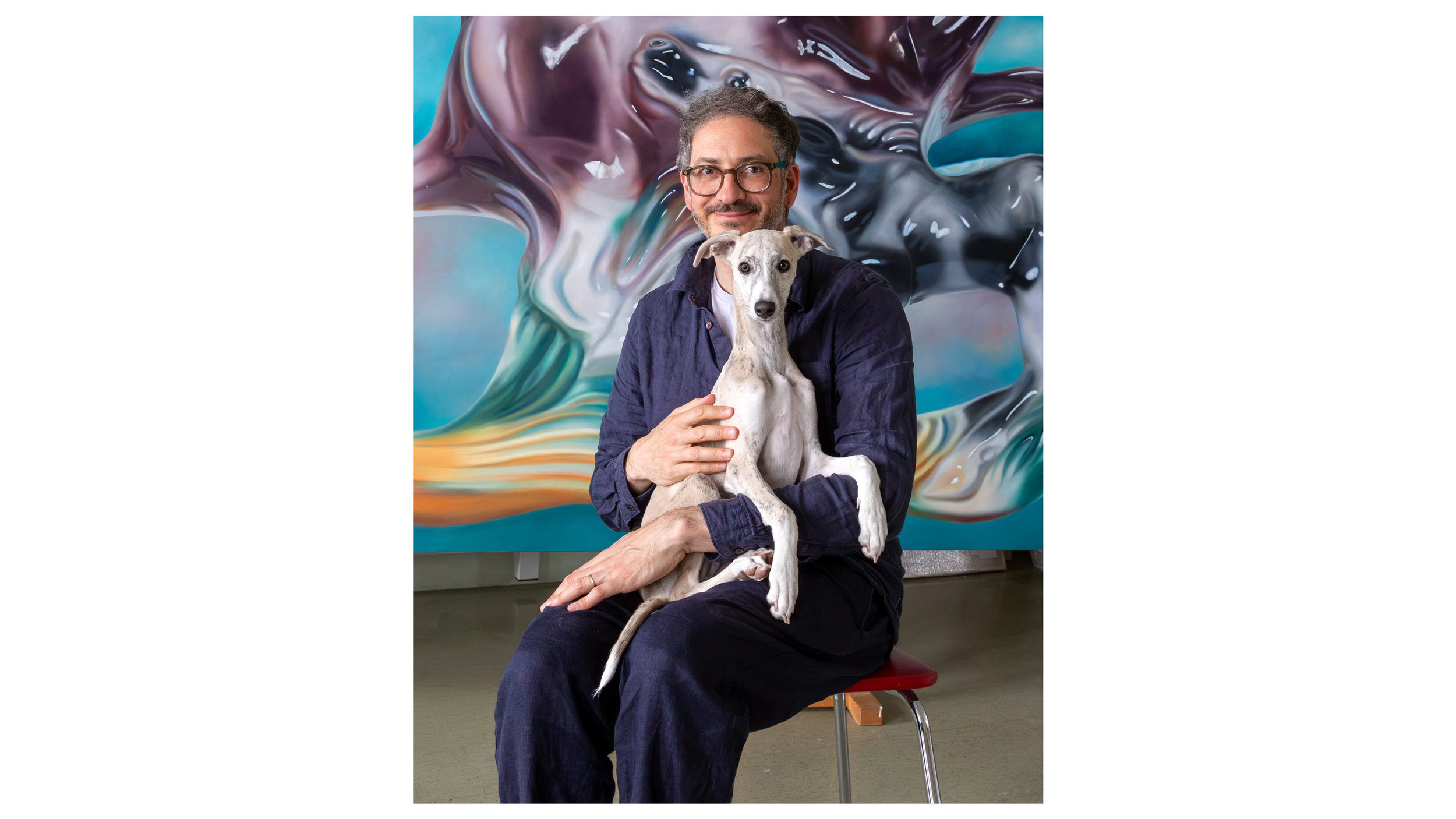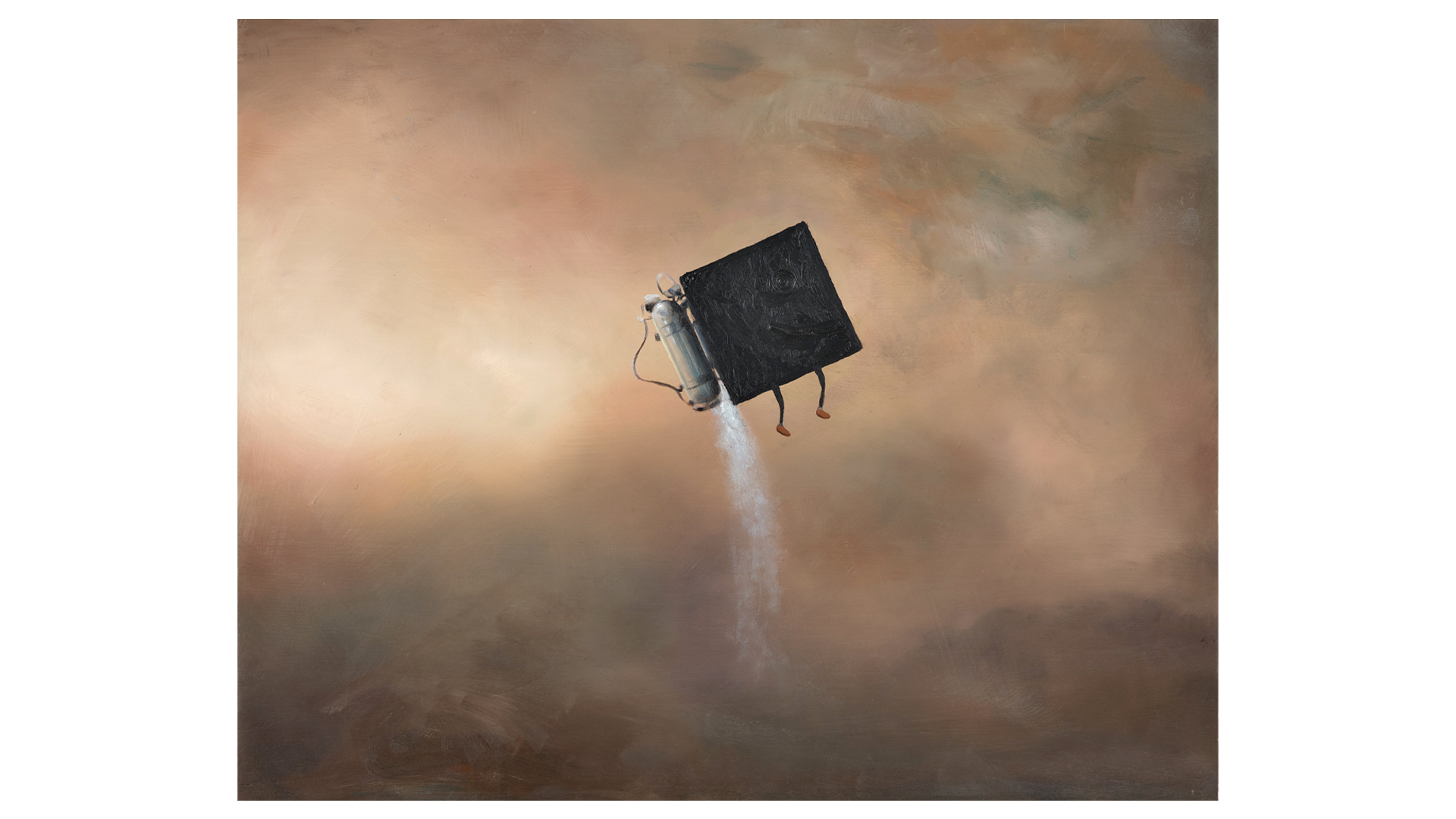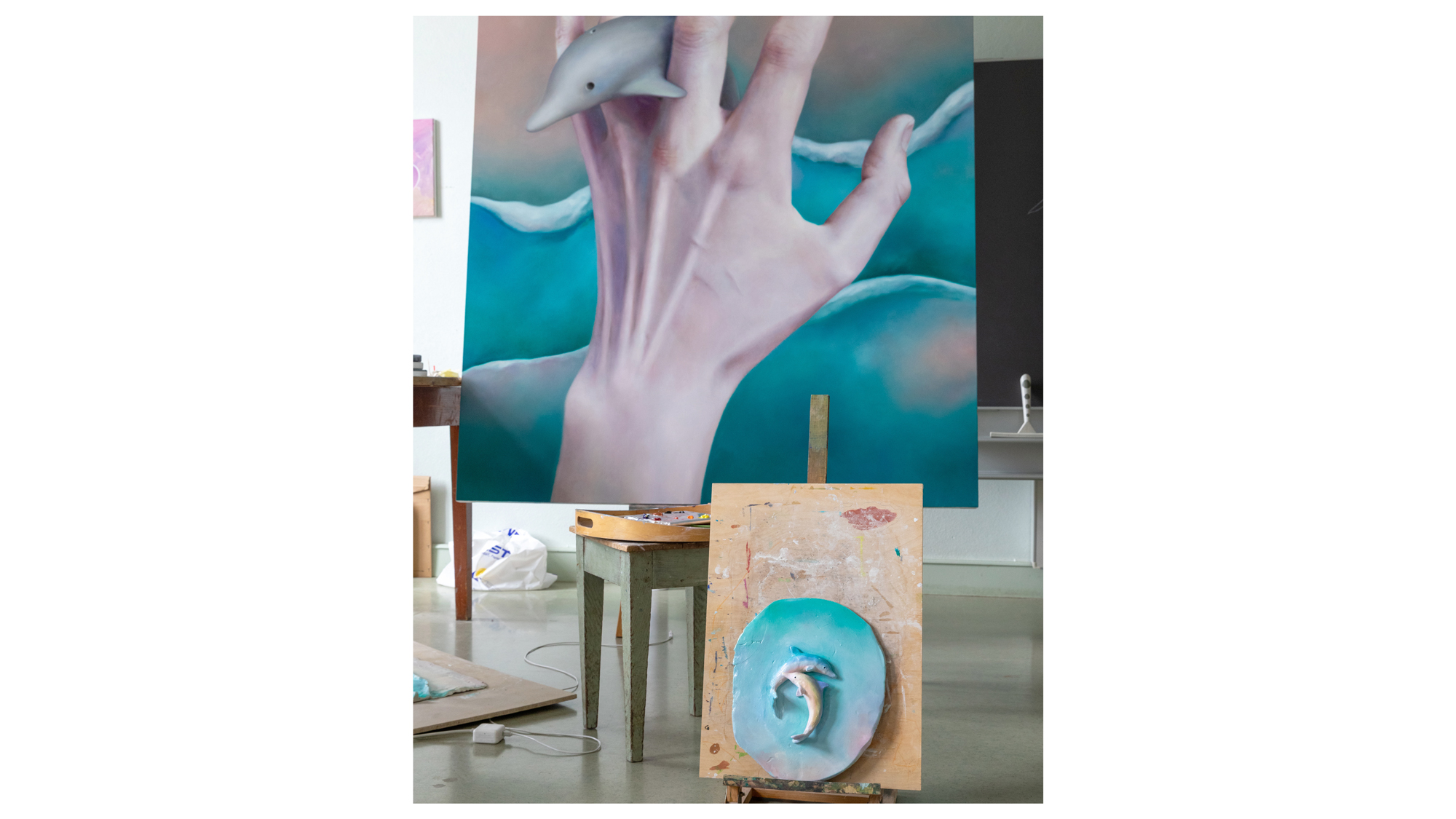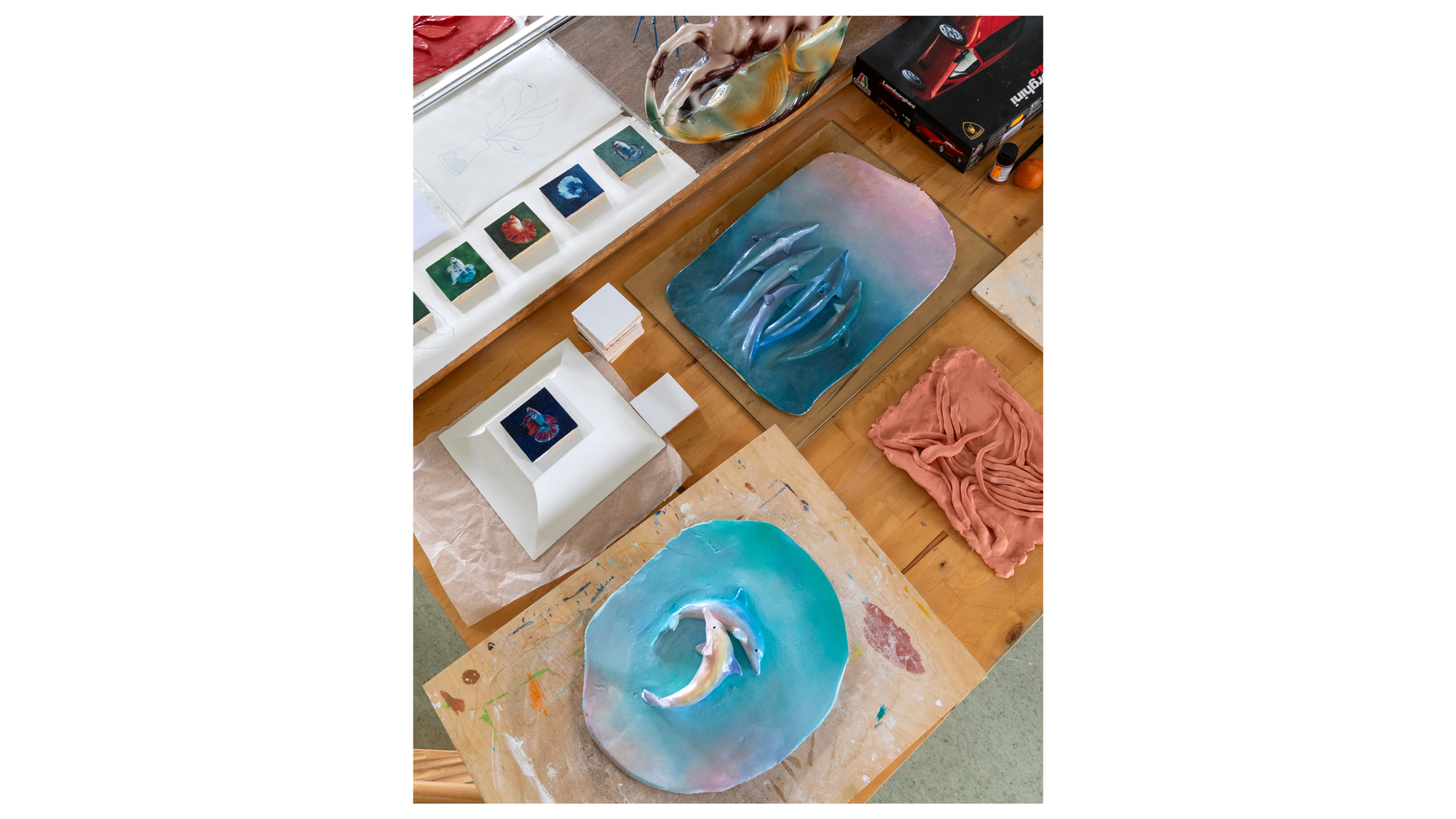THE SUBLIME AND THE RIDICULOUS
 Francisco Sierra with his dog Zephyr, photo: Paula Tyliszczak
Francisco Sierra with his dog Zephyr, photo: Paula Tyliszczak
Technical mastery? Conceptual smartness? Cheeky humour? Francisco Sierra manages to combine all these things in works that are as thoughtful and complex as they are stunningly executed, yet they also come with a certain lightness – and even a bit of fun. The artist is currently showing his work in a solo exhibition at Kunstmuseum Solothurn.
The chances are high that the first thing you notice when looking at a painting by Francisco Sierra is its virtually perfect technical execution. You may wonder about this painter’s incredible skills and his subtle use of colour, about its meticulous and, without a doubt, painstakingly precise application onto the canvas, the seamless shading and the faultlessly rendered reflections – all features that make many of his paintings appear almost lifelike and truly hyper-illusionistic.
But there is more to Sierra’s works than sheer perfection. Take a work like ‘Ancestors’ from the Julius Baer Art Collection. This large canvas from 2014 shows a rocky background into which two strange figures seem to be embedded. They resemble thin sticks, one in a greyish blue and the other in a soft red, both somewhat bulky in form and bending sharply downwards at the top, making them look strangely like something akin to abstracted pelican heads.
 Francisco Sierra (b. 1977), ‘Ancestors’, 2014, oil on canvas, 240 x 170 cm, courtesy the artist and Julius Baer Art Collection
Francisco Sierra (b. 1977), ‘Ancestors’, 2014, oil on canvas, 240 x 170 cm, courtesy the artist and Julius Baer Art Collection
As perfectly rendered as this image may be – with its various shades, faint shimmers, and an almost velvety, lacklustre overall look and feel – its motif appears deeply odd, almost weird, and seemingly not of this world. It is as if an old master, versed in every possible technique of trompe l’oeil painting and with skills honed over long years of practice, decided one day to use this mastery not to imitate reality, but instead to paint a somewhat fantastical, almost surreal and strangely funny idée fixe in the most exhaustive detail.
Skills – but humour, too!
‘I really wanted to be a child prodigy,’ Sierra once said in an interview, adding, ‘I painted my first
oil painting at five.’ Indeed, the artist – who spent his early years in his father’s native country,
Chile, before the family returned to Switzerland – seems to be blessed with talents. As well as painting
in oil at a tender age, he took up the violin as a young boy and eventually decided to study music
instead of attending an art academy. It was not until a later stage that he concentrated on working with
paints and brushes. Sierra may be completely self-taught as a painter, but his style speaks of the utter
discipline needed to truly master a classical instrument – all those endless hours of practice and a
rigorous focus on even the smallest detail.
However, the breathtaking mastery of figurative painting aside, many of Sierra’s works rely on a specific humour that initially seems to be almost at odds with their technical rigour and precision. Some of his canvases even feel outright jokey. Just take a series of paintings featuring flying black squares in which Sierra pays cheeky homage to one of modernist art’s ultimate landmarks, Kazimir Malevich’s ‘Black Square’ from 1915. A 2012 work like ‘Malewitschs Quadrat fliegt mit dem Jetpack davon’ literally depicts what the title describes: a black square with legs which we see flying away with a jetpack; it is a figurative painting that shows all the baggage of modernist painting history, including its central question of abstraction, somewhat comically vanishing into thin air.
 Francisco Sierra (b. 1977), ‘Malewitschs Quadrat fliegt mit dem Jetpack davon’, 2012, oil on wood, 28.5 x 35 cm, courtesy the artist and Julius Baer Art Collection
Francisco Sierra (b. 1977), ‘Malewitschs Quadrat fliegt mit dem Jetpack davon’, 2012, oil on wood, 28.5 x 35 cm, courtesy the artist and Julius Baer Art Collection
Other pieces by Sierra, meanwhile, depict outright strange and surrealistic settings. Consider ‘The Spider King’, a more recent (2023), modestly-sized work. The canvas shows a kitschy, pseudo-romantic sunset over the sea: high upon a cliff, a rather comical spider with the thinnest legs possible is holding up an even smaller baby spider in its ‘arms’, admiring the sinking sun. The title of the work undoubtedly pays reference to a piece of pop culture, namely to the 1994 Disney movie ‘The Lion King’ – except that the overtly majestic atmosphere of the original has become humorously thwarted here by the fragile figure of daddy long legs and its offspring.
 Francisco Sierra (b. 1977), ‘The Spider King’, 2023, oil on canvas, 92 x 73 cm, courtesy the artist and Julius Baer Art Collection
Francisco Sierra (b. 1977), ‘The Spider King’, 2023, oil on canvas, 92 x 73 cm, courtesy the artist and Julius Baer Art Collection
Technical mastery and material misery
A specific strand of Sierra’s practice involves painting studies of purposefully clunky and roughly made
pottery. The final paintings, however, are – once again – the exact contrary: meticulous and seamless
illusions of reality, yet this time of a reality that seems imperfect, sometimes even ready to crumble
away at the faintest touch. This discrepancy between the visible effort and painstaking process of
perfectly executed figurative painting on the one hand and the seemingly improvised, imprecise approach
of many of the motifs on the other points right to the key dialectic in Sierra’s work: between technical
mastery and material misery, as it were; between the sublime power of painting and the deliberately
ridiculous unfinishedness of many of its elements; between the alluring power of a grand illusion and
its conceptual and humorous refracturing. Or, to quote the artist once more from the aforementioned
interview: ‘You must always face your own perfection – or what your idea of perfection is – with a
healthy dose of scepticism.’
Sierra often follows an intricate and multi-level process to arrive at his canvases. Starting with drawings, he goes on to form clay models which he photographs, and the painting is then executed from these images. As slow and seemingly outdated as painting may be, here it becomes the ultimate technology of translation. And by depicting visibly handmade stand-ins and models in a perfect trompe l’oeil manner, Sierra introduces a conceptual twist that visualises the artificiality and mediated nature of contemporary image cultures and our ubiquitous digital environments. In other words: by tricking the eye and seemingly doing away with the painting’s true nature as an image in favour of the ‘real’ thing being depicted, Sierra’s paintings paradoxically show the world to be utterly distanced and refracted. Far from becoming the thing itself (as is the ultimate, and ultimately doomed, promise of trompe l’oeil), they now appear as an image of an image.
The hierarchies of taste
‘Untitled (Just Good Friends)’, a recent (2025) example of Sierra’s clay model works from the Julius
Baer Art Collection showing a cute pair of jumping dolphins, is currently on view in the artist’s solo
show ‘Alfombra’ at Kunstmuseum Solothurn. ‘Alfombra’ means carpet in Spanish, and indeed the literal
carpets covering the beautiful wooden floors of the Kunstmuseum’s old neoclassical rooms have inspired
Sierra’s concept for this show. In a cheeky move, the artist has produced new carpets to be placed on
top of the originals, showcasing prints of wooden floors such as those that lie underneath.
Interestingly, once again, we encounter a moment of imaginary doubling up and aesthetic refraction, a
rupture in taste, material and representation that foregrounds the intertwining of high and low,
tasteful and distasteful.
 Francisco Sierra (b. 1977), ‘Untitled (Just Good Friends)’, 2025, oil on canvas, 170 x 130 cm, courtesy the artist and Julius Baer Art Collection
Francisco Sierra (b. 1977), ‘Untitled (Just Good Friends)’, 2025, oil on canvas, 170 x 130 cm, courtesy the artist and Julius Baer Art Collection
Sierra presents further works on these carpets that highlight seemingly ‘bad taste’ and challenge aesthetic hierarchies. In drastically enlarged versions of the freestanding Plexiglas displays known as L-stands, the artist presents classically varnished oil paintings featuring a paradigmatic sunset motif, rendered utterly kitschy and verging on the banal. ‘These works draw into question the value system embedded in the artistic medium of painting,’ Sierra tells me over the phone when I reach him a few days prior to the show’s opening. ‘I present a banal motif, not unlike a screensaver, but done as a valuable oil painting.’ Another work presented in Solothurn, the massive 2025 triptych ‘Mare e Monti in Mano’, shows, among other motifs, the artist’s hands holding a small model of a dolphin between his fingers. ‘I’ve been occupied with the motif of my hands for quite a while now,’ says Sierra, ‘but so far I haven’t felt confident enough to actually paint them. But now the hands somewhat embody the return of the human figure into my work.’ The handmade nature of Sierra’s artworks is thus represented within the very paintings themselves.
With this focus on the handmade and the slow processes of translating a motif into a painting, Sierra’s practice feels particularly interesting when held against today’s technological advancements in generative AI. ‘I may be working with old painting techniques,’ Sierra comments, ‘but I see myself very much in the here and now.’ Is he worried that AI will soon be taking his job? ‘No, no,’ he answers. ‘The translation work I do, the aspect of the handmade and the specific slowness that comes with my style of painting are things a machine can’t do – at least not yet. In the end, this makes a real difference and creates a value of its own. After all, people still prefer a handknitted pullover over the one they bought at a large discount chain, right?’
Author: Dominikus Müller
Don’t miss the exhibition ‘Francisco Sierra. Alfombra’ at Kunstmuseum Solothurn until 1 January 2026.


